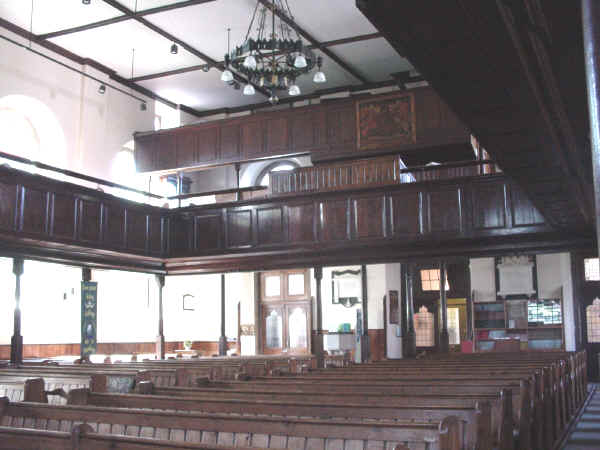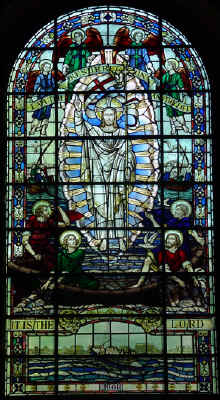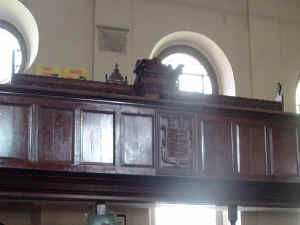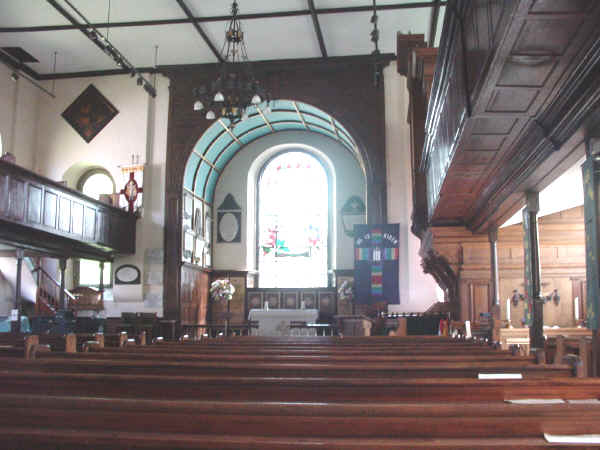| The Civic Church of St George the Martyr, Deal | ||||||
|
PICTURES Rear of church Hope window Corporation pew Organ Nave and Chancel |
 The South and West Galleries and the Upper (Fishermen's) Gallery, added in the 18th century. |
|||||
|
The Civic Church of St George the Martyr, Deal, began life as a Chapel of Ease for the Parish Church of St Leonard. After the granting of the Deal Charter in 1699, the town had its own local government (the Corporation) which was able to address the spiritual needs of the inhabitants of the lower part of the town and ships' crews anchored in the Downs. The parish church was located in the old agricultural community, now known as Upper Deal, a mile from the shore. Lower Deal had grown up behind the shingle bank and was largely inhabited by fishermen and others whose livelihood relied upon the sea. Ships' victualler and town Mayor Thomas Powell, along with magistrate and town Councillor Toby Bowles, led the campaign to build a chapel and, in 1706, successfully petitioned the Archbishop of Canterbury. Two acres of land were purchased from the local brewery for £80 and a subscription list was opened to supplement money from the Corporation. Recognising the benefits of a chapel for naval officers and crews, financial support was offered by Admiral Sir Cloudsley Shovel but, as a result of his untimely death off the Scilly Isles, this never materialised. By then, the foundations and much of the walls had been completed by local builder Samuel Simmonds but it was not until May 1712, when an Act of Parliament was passed imposing a tax on coal imports to the town, that the roof and cupola were added by another local builder, Robert Card, under the supervision of architect John James. The total cost of the building was £2,559, of which £2,117 was supplied by the coal tax. |
 The "Hope" window above the altar at the eastern end of the chancel. The word "HOPE" can just be seen in the bottom centre of the window. This is designed to be read from the outside of the building and is the only remaining piece of the original window (depicting Faith, Hope and Charity) presented by Dr. G. R. Carter in 1867, shattered by a bomb in 1942. The new window was installed in 1950. The lower panel shows part of Deal sea front and the lifeboat. |
|||||
|
The building was consecrated by Archbishop Wake as a Chapel of Ease to the Parish Church of St Leonard on 19th June 1716 and dedicated to St George. In the 285 years since it was opened, the outside of the building has seen little change, except for the addition (in 1822), and later removal (in 1928), of a tower on the West wall containing a staircase to the galleries, and recent extensions to the rear to provide offices, etc. The Priest's Vestry was originally to the right of the altar, but was replaced first by a porch and vestry on the West wall in 1884, and by new vestries added to the West Porch in 1928. A further extension was added in 1981 to provide kitchens, toilets, crèche facilities, an office and meeting room. Internally, however, there have been many changes. The North Gallery was added for the Deal Corporation in 1717 (see picture right). This houses the Corporation Pew and the Mayor's chair (1759). The original seat now stands at the entrance to the gallery, having been replaced in 1898. |
 The Corporation pew in the North Gallery, with the Mayor's seat in the centre. In front of the Mayor's chair is a carved Coat of Arms dating from 1898. |
|||||
|
An organ was installed in the West Gallery in 1816 (see picture right). This was move to the south-east corner of the chancel in the 19th century and replaced by the present organ in 1879. The new organ was rebuilt in 1964. The original font was moved to the centre aisle in 1822. It was replaced by the present font (centre of picture at top of page) in the 1870s. After the choir stalls were removed from the chancel in 1991, a baptismal font for adult immersion was installed under the chancel floor; the only one in an Anglican church in the Canterbury diocese. The original, 3-deck, wooden pulpit was replaced by a stone pulpit in 1869. this in turn was replaced by an oak pulpit in 1939, which was removed along with the choir stalls in 1991. The original box pews were replaced by the current ones in 1876 (very few examples of box pews remain in the UK today). There are plans to remove the pews and replace them with wooden chairs which can easily be rearranged. Other changes to the inside of the building are planned, but recent focus has been on restoring the roof. |
 The magnificent organ, installed in 1879 and rebuilt in 1964, stands in the south east corner of the nave. |
|||||
 View looking east towards the Hope window. The stairs to the galleries can be seen in the north east corner of the chancel. |
||||||
|
The plaque to the left of the Hope window (picture above) is a memorial to Elizabeth Carter (1716-1806) who lived in the house that bears her name at the top of South Street. The ceiling has a 60-foot span and has no supporting pillars. Supported by massive ships' timbers, it cost £628 to build. The original plaster ceiling was replaced with plasterboard in 1991. |
||||||
|
As the church was built at the instigation of the Corporation and partly funded from the public purse, it was agreed from the beginning that the Corporation should: In 1717, the Corporation reserved the sole right to use the front pew in the North Gallery. |
In 1852, St George's became a parish church in its own right, taking the name that heads this page. At the same time, the Vicar claimed the right to appoint the church wardens, with the approval of the pew-holders, who now had to pay for the upkeep and running of the church. From 1883, church wardens were elected by the Vestry meeting, but the Corporation had to agree the appointments. This continued until it was allowed to lapse by the new Town Council was formed in 1955. |
|||||
| Among the many well-known people buried in the churchyard is Captain Edward T. Parker, RN, a close friend of Lord Nelson. His tomb is thought to be the only one paid for personally by the Admiral. |
 Click
on the image to for more information about Capt. Parker and Lord
Nelson. Click
on the image to for more information about Capt. Parker and Lord
Nelson. |
|||||
| Perpetual Curates | Vicars | |||||
| 1716 | William Squire, M.A. | 1852 | Henry Honeywood D'Ombrain, B.A. | |||
| 1718 | Nicholas Carter, D.D. | 1868 | David Bruce Payne, D.D. | |||
|
|
|
|||||
| 1774 | Robert England, M.A. | 1913 | William St. Clair Tisdall, D.D. | |||
| 1783 | Lockhart Leith, M.A. | 1925 | William Edward Daniels | |||
| 1786 | Philip Brandon, LL.B. | (Hon. Canon of Canterbury) | ||||
| 1814 | Montagu Pennington, M.A. | 1936 | Harold Wright Lea-Wilson, M.A. | |||
| 1849 | Henry Honeywood D'Ombrain, B.A. | 1945 | Hamilton Cunningham Paxon, M.A. | |||
| On 5th April 1852, St. George's became a Parish Church | 1954 | Lionel Warren Hart, M.A. | ||||
| 1964 | Owen Thomas Jones, F.C.I.S. | |||||